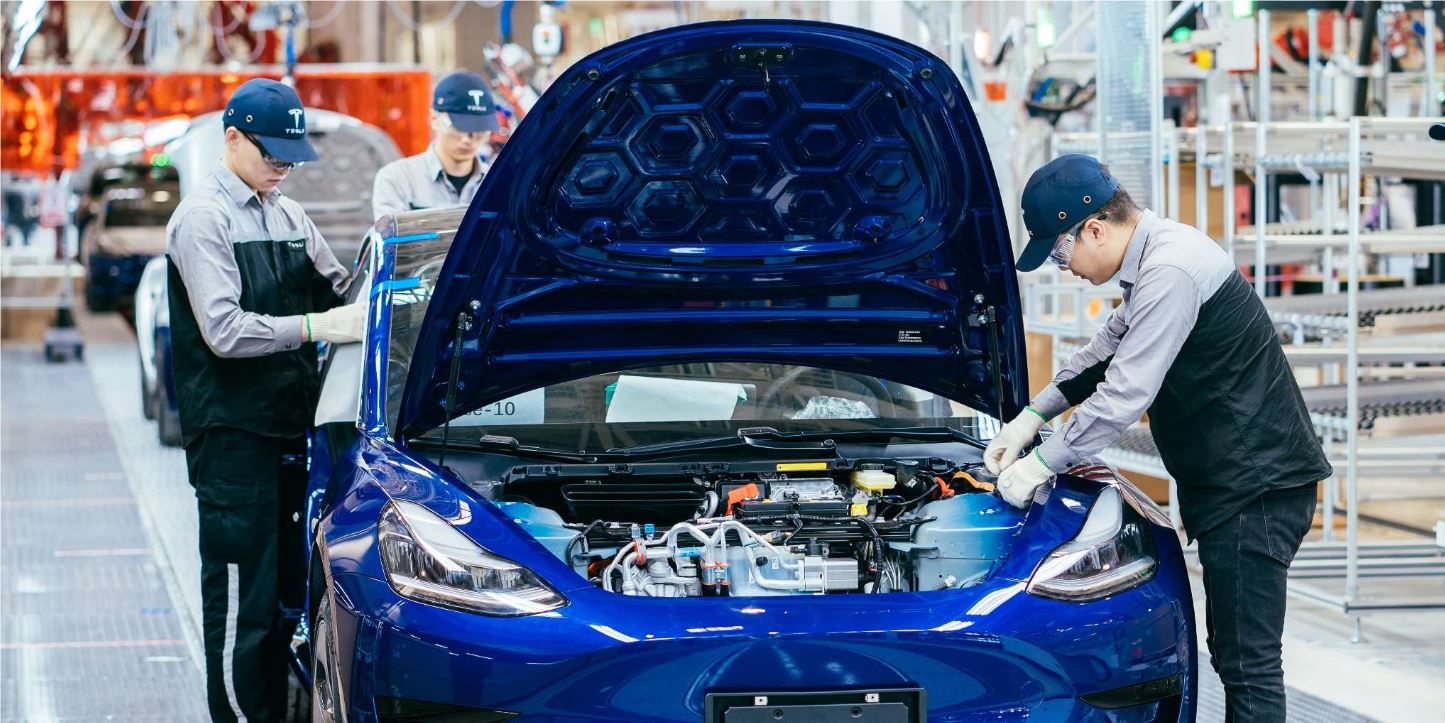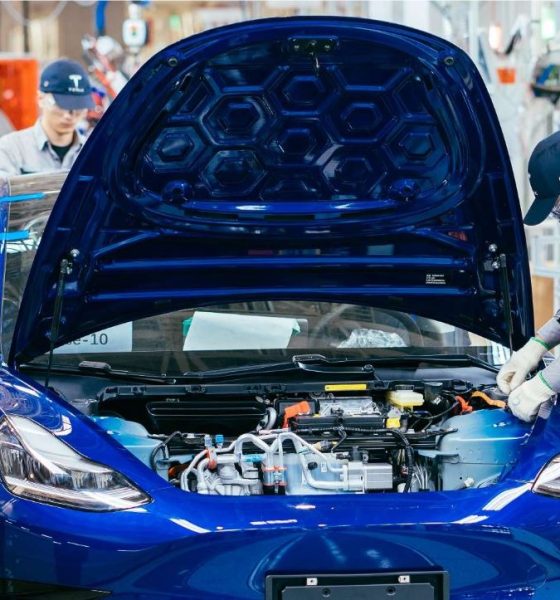

News
Tesla China momentum ‘a positive’ as company navigates new competition
Tesla (NASDAQ: TSLA) had a strong showing in China in May, giving Deutsche Bank a reason to call the company’s performance “a positive” for the company moving forward. However, the Wall Street-based firm has convictions about Tesla’s performance moving forward, according to a new note to investors, as the company will likely face some pushback from Government action and new, local competition.
Figures from the Chinese Passenger Car Association (CPCA) revealed a strong performance in May for Tesla. The Model Y all-electric crossover led the charge ahead of its sibling Model 3 sedan. The numbers catalyzed a sigh of relief from Tesla investors, especially those who read The Information’s report claiming orders had halved to below 10,000 units collectively in China in May. The report was met with criticism and skepticism, including some words from CPCA Secretary General Cui Dongshu, who claimed that May orders wouldn’t have affected May sales figures. Dongshu was correct, as CPCA figures indicated a 29% increase in sales in May compared to April.
The CPCA figures alleviated many concerns, especially those of Deutsche Bank analysts, who revealed in a new note to investors this morning that the strong figures showed healthy demand in both China and Europe, along with hints that Tesla sold its entire Model 3 production capacity in the last two months.
Tesla China sales rise 30% in May, definitively debunks reports of weak demand
The note said (via David Tayar):
“We view May’s data as a positive for Tesla, not only disproving concerns around collapse in demand, but also showing that between local retail sales and exports, Tesla essentially sold its entire Model 3 production capacity in both April and May, and Model Y is ramping up fast in China.”
Deutsche Bank on Tesla/China ??
“We view May’s data as a positive for Tesla, not only disproving concerns around collapse in demand, but also showing that between local retail sales an exports, Tesla essentially sold its entire M3 production capacity in both April/May.”$TSLA pic.twitter.com/o0FMnw0uBG
— David Tayar (@davidtayar5) June 10, 2021
While The Information’s report attributed the weak order figures to “public outcry and government criticism,” Tesla is likely not facing too much of an issue with these two theories, at least for now. However, Deutsche Bank’s note also detailed some concerns that investors may have in the long-term spectacle of Tesla’s Chinese demand.
The firm wrote in its note:
“At the same time, it is unlikely completely eliminate investor concerns that consumer sentiment around Tesla could be losing momentum in China, partly as a result of government action, but also with the rise of local competition. In fact, the article from the Information was supposedly about new orders, rather than sales, so any weakness wouldn’t necessarily have been seen in May sales yet.”
Interestingly, this aligns with Dongshu’s comments about the Information’s report, where the CPCA executive said:
“Usually, monthly sales are accumulated units of orders over previous months, so the immediate results in May might not truly reflect whether the recently reported accidents have had any real impact on Tesla’s sales.”
Tesla has continued a tradition of being one of the most popular automakers in China since its introduction in the market in early 2020. Tesla was the most popular manufacturer in China in 2020, and the only car that has managed to outsell the Model 3 and Model Y is the Wuling HongGuang Mini EV that sells for only $5,000.
Disclosure: Joey Klender is a TSLA Shareholder

Elon Musk
Elon Musk and Tesla AI Director share insights after empty driver seat Robotaxi rides
The executives’ unoccupied tests hint at the rapid progress of Tesla’s unsupervised Robotaxi efforts.

Tesla CEO Elon Musk and AI Director Ashok Elluswamy celebrated Christmas Eve by sharing personal experiences with Robotaxi vehicles that had no safety monitor or occupant in the driver’s seat. Musk described the system’s “perfect driving” around Austin, while Elluswamy posted video from the back seat, calling it “an amazing experience.”
The executives’ unoccupied tests hint at the rapid progress of Tesla’s unsupervised Robotaxi efforts.
Elon and Ashok’s firsthand Robotaxi insights
Prior to Musk and the Tesla AI Director’s posts, sightings of unmanned Teslas navigating public roads were widely shared on social media. One such vehicle was spotted in Austin, Texas, which Elon Musk acknowleged by stating that “Testing is underway with no occupants in the car.”
Based on his Christmas Eve post, Musk seemed to have tested an unmanned Tesla himself. “A Tesla with no safety monitor in the car and me sitting in the passenger seat took me all around Austin on Sunday with perfect driving,” Musk wrote in his post.
Elluswamy responded with a 2-minute video showing himself in the rear of an unmanned Tesla. The video featured the vehicle’s empty front seats, as well as its smooth handling through real-world traffic. He captioned his video with the words, “It’s an amazing experience!”
Towards Unsupervised operations
During an xAI Hackathon earlier this month, Elon Musk mentioned that Tesla owed be removing Safety Monitors from its Robotaxis in Austin in just three weeks. “Unsupervised is pretty much solved at this point. So there will be Tesla Robotaxis operating in Austin with no one in them. Not even anyone in the passenger seat in about three weeks,” he said. Musk echoed similar estimates at the 2025 Annual Shareholder Meeting and the Q3 2025 earnings call.
Considering the insights that were posted Musk and Elluswamy, it does appear that Tesla is working hard towards operating its Robotaxis with no safety monitors. This is quite impressive considering that the service was launched just earlier this year.
Elon Musk
Starlink passes 9 million active customers just weeks after hitting 8 million
The milestone highlights the accelerating growth of Starlink, which has now been adding over 20,000 new users per day.

SpaceX’s Starlink satellite internet service has continued its rapid global expansion, surpassing 9 million active customers just weeks after crossing the 8 million mark.
The milestone highlights the accelerating growth of Starlink, which has now been adding over 20,000 new users per day.
9 million customers
In a post on X, SpaceX stated that Starlink now serves over 9 million active users across 155 countries, territories, and markets. The company reached 8 million customers in early November, meaning it added roughly 1 million subscribers in under seven weeks, or about 21,275 new users on average per day.
“Starlink is connecting more than 9M active customers with high-speed internet across 155 countries, territories, and many other markets,” Starlink wrote in a post on its official X account. SpaceX President Gwynne Shotwell also celebrated the milestone on X. “A huge thank you to all of our customers and congrats to the Starlink team for such an incredible product,” she wrote.
That growth rate reflects both rising demand for broadband in underserved regions and Starlink’s expanding satellite constellation, which now includes more than 9,000 low-Earth-orbit satellites designed to deliver high-speed, low-latency internet worldwide.
Starlink’s momentum
Starlink’s momentum has been building up. SpaceX reported 4.6 million Starlink customers in December 2024, followed by 7 million by August 2025, and 8 million customers in November. Independent data also suggests Starlink usage is rising sharply, with Cloudflare reporting that global web traffic from Starlink users more than doubled in 2025, as noted in an Insider report.
Starlink’s momentum is increasingly tied to SpaceX’s broader financial outlook. Elon Musk has said the satellite network is “by far” the company’s largest revenue driver, and reports suggest SpaceX may be positioning itself for an initial public offering as soon as next year, with valuations estimated as high as $1.5 trillion. Musk has also suggested in the past that Starlink could have its own IPO in the future.
News
NVIDIA Director of Robotics: Tesla FSD v14 is the first AI to pass the “Physical Turing Test”
After testing FSD v14, Fan stated that his experience with FSD felt magical at first, but it soon started to feel like a routine.

NVIDIA Director of Robotics Jim Fan has praised Tesla’s Full Self-Driving (Supervised) v14 as the first AI to pass what he described as a “Physical Turing Test.”
After testing FSD v14, Fan stated that his experience with FSD felt magical at first, but it soon started to feel like a routine. And just like smartphones today, removing it now would “actively hurt.”
Jim Fan’s hands-on FSD v14 impressions
Fan, a leading researcher in embodied AI who is currently solving Physical AI at NVIDIA and spearheading the company’s Project GR00T initiative, noted that he actually was late to the Tesla game. He was, however, one of the first to try out FSD v14.
“I was very late to own a Tesla but among the earliest to try out FSD v14. It’s perhaps the first time I experience an AI that passes the Physical Turing Test: after a long day at work, you press a button, lay back, and couldn’t tell if a neural net or a human drove you home,” Fan wrote in a post on X.
Fan added: “Despite knowing exactly how robot learning works, I still find it magical watching the steering wheel turn by itself. First it feels surreal, next it becomes routine. Then, like the smartphone, taking it away actively hurts. This is how humanity gets rewired and glued to god-like technologies.”
The Physical Turing Test
The original Turing Test was conceived by Alan Turing in 1950, and it was aimed at determining if a machine could exhibit behavior that is equivalent to or indistinguishable from a human. By focusing on text-based conversations, the original Turing Test set a high bar for natural language processing and machine learning.
This test has been passed by today’s large language models. However, the capability to converse in a humanlike manner is a completely different challenge from performing real-world problem-solving or physical interactions. Thus, Fan introduced the Physical Turing Test, which challenges AI systems to demonstrate intelligence through physical actions.
Based on Fan’s comments, Tesla has demonstrated these intelligent physical actions with FSD v14. Elon Musk agreed with the NVIDIA executive, stating in a post on X that with FSD v14, “you can sense the sentience maturing.” Musk also praised Tesla AI, calling it the best “real-world AI” today.








